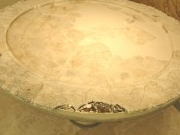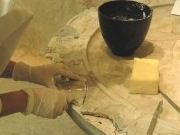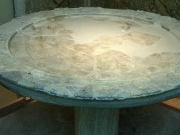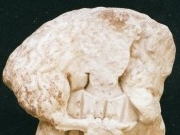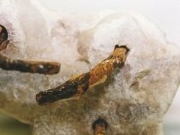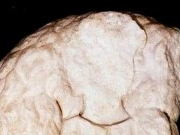Sculpture Conservation Workshop
The Museum’s Sculpture collection contains some 2,000 architectural and decorative elements dating from between the Early Christian period and the 19th century. Mostly marble, though with some limestone, the artefacts range in size from 1.5 metres to 12 cm.
Work began conserving the Museum’s sculptures shortly before its collections were exhibited for the first time in 1930. A number of sculptures were built into the walls at this time, with missing material being replaced by plaster additions, although the bulk of the sculptures remained exposed to the elements in the Museum courtyard for many years due to a lack of space. In the 1960s, a special team headed by the marble craftsman, Manolis Noukakis, undertook the conservation of the sculptures in the courtyard, making interventions required to mount and display the sculptures, making extensive plaster additions needed to complete the original decorative motifs, and emergency interventions such as the re-attachment of fragments that had broken off the sculptures.
The sculpture conservation workshop has been up and running since 1987, headed by the artist and conservator Christos Stavrakas. The Workshop moved into the Museum’s new wing in 2002, and currently employs two conservators.
The problems caused by the manner in which the sculptures were displayed in the past relate to:
a) deterioration caused by interaction with the environment (biological factors, oxidization stemming from the products of the corrosion of the metal links used etc.); and
b) previous conservational interventions, which were often both extremely extensive and irreversible.
Today, the workshop’s focus is on creating a controlled environment designed to minimize any further deterioration. The bulk of the collection has now been moved into new storage facilities, and a schedule has been drawn up for studying and documenting the artefacts’ state of preservation.
New interventions include stabilizing the factors of corrosion, surface cleaning, the provision of support structures, the attachment of sections that have broken off, the application of titanium links, and additions, where judged essential. Since these interventions are geared towards restoring the sculpture in a manner respectful of the sculptures’ makers, age and historical/aesthetic value, extensive additions are ruled out. Non-destructive materials and methods are used in combination with inter alia macroscopic and microscopic examination, qualitative and quantitative analyses of corrosive deposits and observation.
The workshop’s conservators participate in meetings, conferences and research programmes as well as collaborating with other educational and research bodies with a view to applying new conservation methods and materials. In this context, the workshop helped define the parameters for laser conservation systems through its participation in the European Lastor programme (2003-2006) and its evaluation of the cleaning of sculptures in the BCM collection.
The workshop’s current projects includes collaborating with the University of Athens in a research programme investigating biological factors responsible for damage to the Museum’s sculptures. Understanding the mechanisms behind the effects of biological organisms and their identification and classification will contribute to the search for a more effective way of dealing with such threats.
The various tasks associated with the exhibition of artefacts from the sculpture collection are usually undertaken by the workshop in collaboration with external associates – especially in the case of bulky or heavy pieces. For instance, a schedule was drawn up in 2003, in view of the upcoming re-exhibition of the Museum’s Byzantine collections, to detach 165 sculptures from the old exhibition space and re-exhibit them using new internal titanium supports where appropriate.








